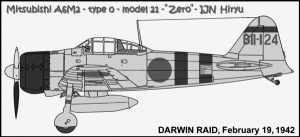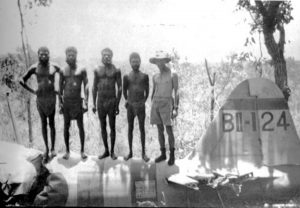- Author
- A.N. Other
- Subjects
- Biographies and personal histories, WWII operations, History - WW2
- Tags
-
- RAN Ships
- None noted.
- Publication
- March 2013 edition of the Naval Historical Review (all rights reserved)
By David Mattiske
This wreckage of a Japanese Reisen (Zero) B11-124 Cn 5349 was that of an aircraft flown by Sgt Pilot Hajime Toyoshima during the first Japanese bombing raid on Darwin on 19 February 1942. Toyoshima later died in the Japanese POW breakout at Cowra on 5 August 1944. The engine seized due to a .303 rifle bullet entering the oil tank and she crash landed on Melville Island.
Taken from an inscription at the Darwin Heritage Museum
For a few seconds they were only a few feet apart. But this meeting, if it could be called a meeting, was to have a profound impact on their lives.
February 19th 1942 dawned bright and clear over the northern coastline of Australia and the Arafura Sea. Admiral Naguma commanding the Japanese aircraft carrier force, the same force which had devastated Pearl Harbour two months previously, turned his ships into the wind to enable his aircraft to take off. He would despatch 152 bombers and 36 Zero fighters to Darwin on the first time that an enemy attacked Australian soil. On board the aircraft carrier Hiryui was Zero number 5349, tail code B11‑124, flown by Flyer First Class (Sergeant) Hajime Toyoshima. He was one of the highly trained Japanese pilots especially chosen for their skill, aggression and dedication. Only the best were picked for the dangerous and difficult task of flying aircraft off aircraft carriers.
The Zero roared off Hiryui, joining the force of 188 fighters and bombers as they formed up and set course for Darwin. Toyoshima had been allotted the task, among other duties, of attacking the Royal Australian Navy ships that controlled the traffic in and out of the harbour by means of the harbour boom defence system. On arrival over Darwin Toyoshima flew around over the town area and then concentrated on the ships in the harbour. With another Zero Toyoshima headed for the harbor, sweeping in at low level from the northwest, causing damage and casualties to HMA Ships Kara Kara and Kookaburra. Their course took them straight at the Navy Office near the water’s edge at East Point, roaring along at only 150 to 200 feet above the water.
As Germany re-armed and war clouds gathered in 1938, Frederick Sydney (Syd) Sharp was acutely aware that Australia needed to be prepared. He had initially joined the Army Reserves but then decided on a transfer to the Royal Australian Navy Volunteer Reserve. He was obviously capable and on 16 February 1939 was commissioned with the rank of Sub-Lieutenant. His Commission was signed by Lord Gowrie, a much prized signature of a highly regarded Governor General of exceptional capabilities. Syd completed the Anti Submarine Detection course with flying colours and became an expert in that field.
With Japan looming as a threat in the north, Syd was posted to Darwin and promoted to Acting Lieutenant, and was responsible for the indicator loops forming part of the harbour’s anti-submarine defences. His Army experience had nurtured an interest in shooting and he always kept a .303 rifle in his office on the waterfront at East Point. On the morning of the 19th Syd was taking a short break sitting in a chair outside his office overlooking the harbor. He became aware of the sound of the approaching Japanese aircraft, quickly grabbed his rifle and jumped into a shallow slit trench. The destruction of the town continued for about thirty minutes and then the Japanese concentrated on the ships in harbour. Syd estimated that at about 1030 two Japanese fighters were roaring in from the northwest, guns blazing away at Kara Kara and Kookaburra. Their course took them over these ships, straight at East Point where Syd and a few others were stationed. Syd took aim with his .303 rifle and fired. ’You’re hitting him’ was the call, but the Zeros roared on just a few feet overhead.
The shock of the Darwin raid with massive destruction and huge casualties, and the urgent need to prepare for further attacks meant that this incident was not recorded, and thus forgotten. After his attack on the ships Sergeant Toyoshima climbed to a normal flying height and headed northwest. As he approached Melville Island his engine seized and he glided to a forced landing on that island. Tiwi islander Matthias Ungura watched the Zero crash land, and ran to the scene, securing the first Japanese prisoner of war captured by the Allies. He took possession of the dazed Toyoshima’s pistol and with friends sailed across to Bathurst Island and handed the luckless Japanese pilot over to Sergeant Leslie Powell of the Australian Army. Ashamed of virtually delivering the first Navy Zero to the enemy and not dying for the Emperor, Hijume Toyoshima gave a false name and said he had flown from Ambon. All Australian records show him under his assumed name of Tadeo Minami and that is how he completes his story and his tragic life. Japanese Servicemen firmly believed that they must serve and die for their cause. To do otherwise was a disgrace for them and their families. As prisoners of war they chafed under a heavy burden, the fact that they had been caught alive was shameful and many of them longed for redemption. Tadeo Minami was one of these.
By August 1944 nearly a thousand Japanese prisoners were held in a camp at Cowra. As a non-commissioned officer Tadeo Minami was an aggressive leader, dreaming of and plotting a breakout. The Japanese learned that Australian Army authorities were to separate the men from their non-commissioned officers. This was devastating news, for the well-being and orderly functioning of a unit depends on the relationships between the men and their immediate leaders, particularly so amongst the Japanese.
A breakout was organised and during the night of 4/5th August 1944, Minami blew a bugle to start the breakout. Hundreds of Japanese charged the barbed wire fences and many were killed by the guard’s fire; many others simply took their own lives in the wild confusion. They gave their lives to redeem themselves from the disgrace they had brought upon themselves and their families. Tadeo Minami was caught in a hail of machine gun fire and lay wounded. He was not fatally wounded but used a kitchen knife which he thrust into his throat and died the death he so desired. With his comrades he is buried in the Memorial Gardens erected at the former camp site at Cowra, a place of significance in Australian and Japanese history.
Lieutenant Sydney Sharp went on to other naval posts at Cairns, which was an important base for the counter offensive against Japan. After the war he remained an active officer in the Reserves, and became famous as Commodore of the Royal Australian Naval Sailing Association in 1969 and 1970. In the early 1960s Syd was asked if he could accept a guest on his yacht for a Saturday race on Sydney Harbour. The guest wished to enjoy a sail as he had not done so for many years. On enquiring the identity of the mysterious guest Syd was informed it was Vice Admiral Sir John Collins. Syd gave the proper reply: He was welcome, but as Syd was the officer in charge his orders would have to be obeyed at all times. Needless to say, our famous Admiral appreciated the common sense of ‘Captain Syd’ and a pleasant cruise was had by all. After a successful business career in Sydney, Syd and his charming wife Linda bought a waterfront unit on the Gold Coast where Syd can gaze out on the mountains to the west or, more likely, to his beloved salt water ocean in the east.
Did Syd actually shoot down Hajime Toyoshima? There is a volume of information about the first great raid on Darwin, including pictures of Hajime Toyoshima’s Zero. During this raid many Zeros and Vals flew low and were within range of small arms fire. Accordingly there are a number of claimants to the distinction of shooting down this aircraft. After examination it was found that: Imperial Japanese Navy A6M2 Zero, Serial Number 5349 coded Bll-1244 was hit in the oil tank by a single .303 rifle bullet over Darwin Harbour. When the engine seized and the propeller sheared off, Pilot Hajime Toyoshima crash-landed his damaged aircraft on Melville Island. While the evidence is not conclusive Lieutenant Sydney Sharp, VRD, RANVR is rightfully amongst the claimants to be the first man in World War II to shoot down a Zero fighter aircraft with a shot from a .303 rifle.






